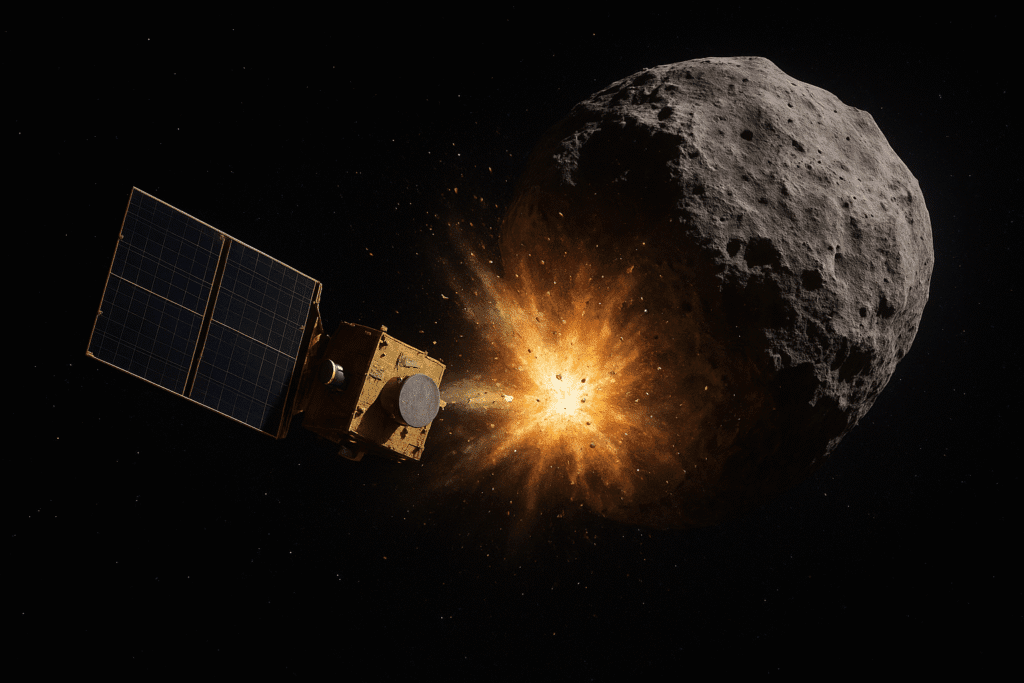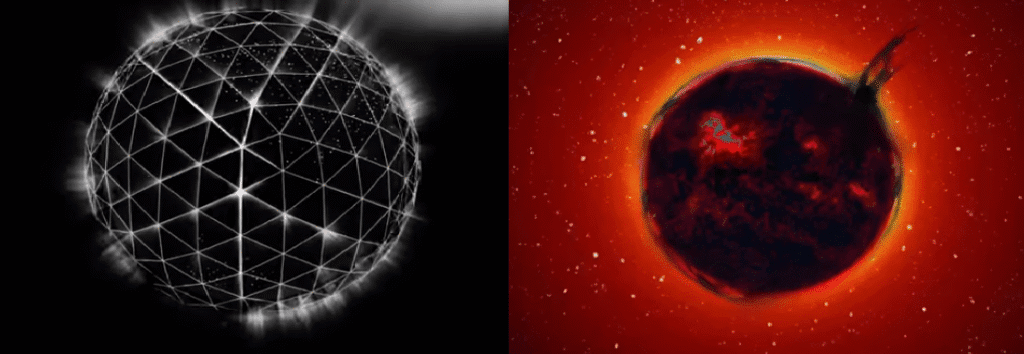
In September 2022, the Double Asteroid Redirection Test (DART) mission by NASA made history: for the first time, humanity attempted an asteroid deflection test by intentionally crashing a spacecraft into it. Its target: Dimorphos, the small moonlet of the binary‐asteroid system orbiting Didymos. The main goal was simple yet profound: to test whether we can alter an asteroid’s path and so one day defend Earth from a genuine threat.
✅ The Mission of Asteroid Deflection Test: A Clear Success
When the DART spacecraft collided with Dimorphos, scientists expected a modest shift in its orbit—on the order of minutes. But the results were far beyond baseline expectations. Pre-impact, Dimorphos completed its orbit around Didymos every 11 hours and 55 minutes. After the impact, the orbital period shortened by about 33 minutes.
Essentially, a relatively small spacecraft (about the size of a vending machine) proved that a kinetic impactor can significantly alter an asteroid’s trajectory, a major step for planetary defence.
❓ The Puzzle: Unexpected Behaviours and Hidden Complexities of Asteroid Deflection Test
While the mission’s headline result (orbit shortened) was a clear success, deeper analysis revealed puzzling outcomes that complicate our understanding of asteroid deflection. Here’s what stands out:
- Momentum beyond the impact: Researchers found that the momentum transferred to Dimorphos exceeded what the spacecraft itself delivered. This was due to large amounts of ejecta—rocky debris blasted off the surface—which acted like a secondary “rocket-blast”.
- Strange debris behaviour: A new study found that many of the boulders ejected from the asteroid did not spread uniformly. Instead, they formed clusters with distinct trajectories—some moving almost perpendicular to the asteroid’s original orbit. This was unexpected and suggests that the surface structure and internal makeup of the asteroid play a major role in how deflection works.
- Possible shape and orbit changes: Post‐impact analyses showed that Dimorphos may have changed shape (from a “squashed sphere” to more elongated) and that its orbit may have become slightly eccentric rather than a perfect circle.
- Lingering uncertainties: Some changes were detected weeks after the impact and are still not fully explained. For instance, a further slight shortening of the orbit (seconds rather than minutes) might have happened, but whether this represents real physical change or measurement noise remains open.
🔍 Why This Matters for Future Asteroid Deflection Missions
These puzzles are important because future missions aiming to protect Earth from hazardous asteroids will require precise predictions of how an asteroid will respond to a deflection attempt. Miss a variable and you might change the orbit in unintended ways—or worse, fragment the target into unpredictable debris.
- The fact that ejecta momentum dominated means simply hitting the target isn’t enough: the internal structure and surface composition (loose “rubble pile” vs. solid rock) will significantly alter outcomes.
- The directionality of debris matters: if rocks fly off sideways or in unexpected directions, the net effect on the asteroid’s orbit could be different from what is predicted.
- Shape change and orbit evolution: Altering an asteroid’s spin, shape, or mutual gravitational interactions (in the case of binary asteroids) adds complexity.
- Risk of unintended consequences: Some studies even raise scenarios where fragments or ejecta might pose secondary risks (though not in this DART case).

🧠 Asteroid Deflection – What We Learn Going Forward
The DART mission demonstrates two things: 1) that asteroid deflection via kinetic impact is viable; and 2) that our models need refining. With these lessons in hand, scientists are planning follow-up missions, such as the Hera mission by the European Space Agency (ESA) to study the Didymos/Dimorphos system in even greater detail.
For planetary defence strategies, the takeaway is clear: detection alone isn’t enough. We must understand the target thoroughly—its composition, structure, rotational state, binary nature—and model the asteroid deflection accordingly with contingency plans for unusual behaviour.
📝 Conclusion
The DART mission was a landmark for human space exploration and planetary defence. But the “puzzling outcome” isn’t a failure—it’s a reminder that the universe doesn’t always behave in simple, textbook ways. Each mission teaches us more about the unpredictable nature of space rocks, and each lesson refines our ability to protect our planet.
As we look ahead, the success of DART gives hope—and the mysteries it revealed give purpose. The next time a dangerous asteroid heads our way, we’ll be better equipped not only because we can hit it, but because we’ll better understand how it will respond when we do.

